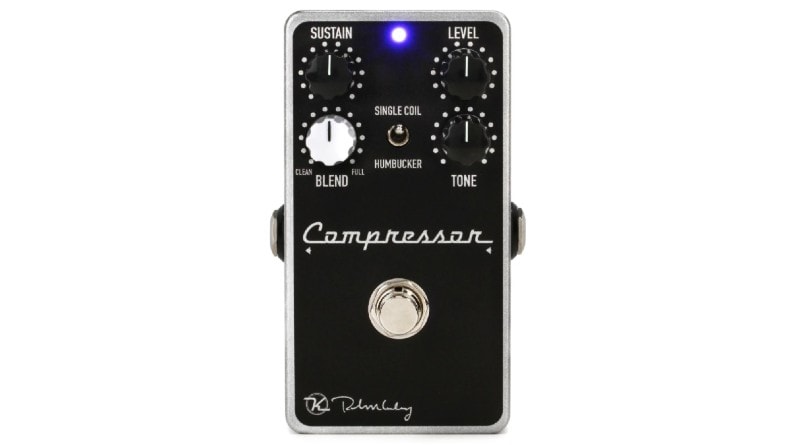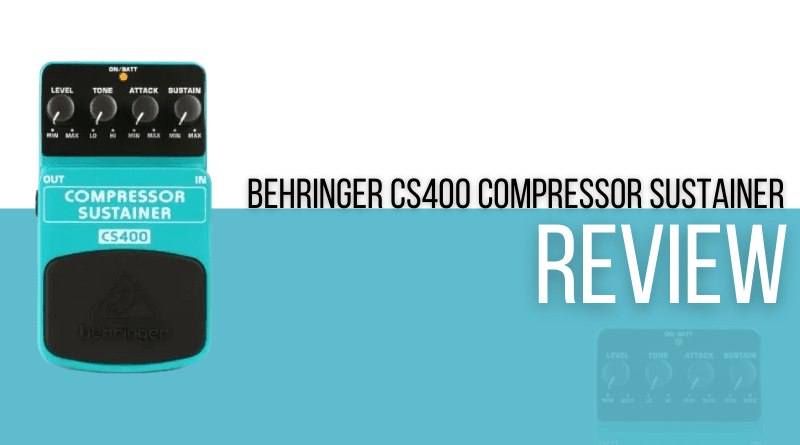Behringer’s pedal line is making quite a stir in the guitar industry at the moment. With their range of affordable equivalents to some of the world’s most popular models, they’ve almost single handedly changed the face of the FX industry – no longer are players on a budget limited to multi FX units, now value conscious guitarists have genuine options when it comes to curating a custom pedal board without breaking the bank.
One such offering from Behringer is their CS400 Compressor Sustainer Pedal. This model has drawn inspiration from the ever popular Boss CS-3 Compression Sustainer, but can it really achieve the same results? Read on to find out as we put the CS400 to the test.
Read more about our review process.
Contents
Behringer CS400: Who Is This Pedal For?
The Behringer CS400 Compressor Sustainer is aimed at intermediate to advanced guitarists. Of course, it’s affordable at all levels of the player spectrum, but this specific type of pedal is targeting players who already know the fundamentals, and who are now trying to perfect their sound.
Typically, compression sustainer pedals are used by guitarists playing in bands. They effectively boost quiet signals and compress louder signals, keeping your tone more consistent. At the same time, they reduce compression to your signal as it decays, which helps to increase sustain. In all, this can help players cut through a mix more effectively without having to adjust levels mid set.
Because of their intended use, they aren’t necessarily a must have for a player who is just learning the fundamentals on their own, but once you start jamming with friends, a CS400 would be a sound investment.
Behringer CS400: Appearance / Features / Controls
Being a Behringer pedal, the outer shell is made of plastic, and in this case, it’s finished in an attractive teal color. Despite the plastic housing, it’s still reasonably sturdy, and unless you stomp on it forcefully, it should hold together well.
The CS400 can be powered by a 9v battery or by the Behringer PSU-SB DC power supply, which unfortunately, is sold separately. We tested the pedal using just a battery, and we can happily report that it was able to keep the pedal powered for at least 8 hours. Accessing the battery compartment itself was a challenge, and was probably our least favorite thing about this pedal.
The pedal has a single line in and a single line out jack. It’s fitted with 4 rotary dials for level, tone, attack, and sustain. The level dial controls the overall output volume from the pedal. Tone allows you to change the EQ bias from lows, to mids, or trebles (and remember not to put an EQ in front of this as you’ll end up compressing noise). The attack knob allows you to adjust how quickly the compressor reacts to the input signal. Finally, the sustain knob allows for control over how much compression is applied to the decaying signal to boost sustain or to leave it natural.
Behringer CS400: Performance/Sound
As always, to get a good baseline sound, we started our test clean and direct to amp. Immediately afterwards, we plugged into the Behringer CS400 Compressor Sustainer, but left it turned off, this allowed us to see if the lack of a true bypass had much, if any impact on the dry sound.
Fortunately, we discovered that it had practically no impact. Plugged into our 5 watt tube amp, we heard no discernible difference in tone or noise with the guitar direct to the amp, vs being played through the pedal, with the power off.
The next stage of the test saw us setting all controls to noon and turning on the pedal. We immediately noticed the volume boost, and a slight increase in noise. We started with some quiet finger picking, and we were honestly blown away with just how organic the boost was, in fact, it was even more natural sounding than the Boss CS-3 that this pedal is based upon.
After we’d played around with the low level boost, we wanted to check out the compression capabilities, so we moved on to some heavy strumming with the level cranked up, and the tone set to about 2 o clock. Once again, this pedal impressed – it kept the sound tight and compact, with no harsh overtones. This would really do a great job of letting a rhythm player provide presence without crowding the mix.
The sustain control was a favorite of ours during the test. We turned it all the at to zero, which pretty much killed any ringing out, resulting in sharp staccato like tones, but when we maxed it out, we could hold notes for what seemed like an eternity. This is a really handy feature for players with lighter guitar’s that might otherwise struggle with natural sustain.
One slight drawback we noted was the amount of noise we experienced with the sustain set at maximum. It didn’t make this setting unusable, but it was definitely a noticeable amount of unwanted interference.
Considering the low cost, we found that each dial had a great sweep from the potentiometer, allowing fine control with no noticeable drop off or binary effect. In all, the sound performance way surpassed expectations.
Other Compressor Sustain Pedals to Consider
Of course, there are dozens of other great compressor sustain pedals to choose from. If the Behringer CS400 doesn’t sound like something you’d be interested in, maybe consider one of these alternatives.
Boss CS-3 Compression Sustainer

The Boss CS-3 is clearly the pedal that Behringer wanted to emulate with their CS400, and with that in mind, it is functionally identical to the Behringer. It does, however, have the advantage of being made with a metal housing, and it also has a battery compartment that does not require tools to access. If those features are enough to justify the additional cost to you, this a strong choice.
Keeley Compressor Plus

The Keeley Compressor Plus is a boutique compressor pedal with some features you’re sure to love. The compression itself from this pedal is as smooth as it gets, and thanks to its blend control, you can seamlessly merge your dry tone in to the compressed output, which results in some of the most natural sounding compression on the market. This pedal also features a single coil/humbucker switch, allowing you to tailor the compression level based on your guitar’s electronics.
Final Thoughts on the Behringer CS400
If you’ve joined a band, if you’ve started jamming with friends, or you’re really just starting to take your guitar playing more seriously, a compressor sustain pedal like the Behringer CS400 will really help you to perfect your sound. It offers, in our opinion, a more natural sound than some of its more expensive competitors, and while construction quality matters, it’s the tone that matters more to the average player. Once again, Behringer has produced a bargain pedal that we’d happily include on our board, and we’d recommend you do the same!
Check out these other articles you might like:


